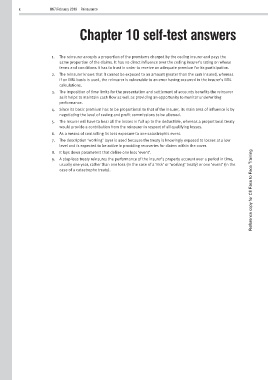Page 368 - M97TB9_2018-19_[low-res]_F2F_Neat2
P. 368
x M97/February 2018 Reinsurance
Chapter 10 self-test answers
1. The reinsurer accepts a proportion of the premiums charged by the ceding insurer and pays the
same proportion of the claims. It has no direct influence over the ceding insurer’s rating on whose
terms and conditions it has to trust in order to receive an adequate premium for its participation.
2. The reinsurer knows that it cannot be exposed to an amount greater than the sum insured, whereas
if an EML basis is used, the reinsurer is vulnerable to an error having occurred in the insurer’s EML
calculations.
3. The imposition of time limits for the presentation and settlement of accounts benefits the reinsurer
as it helps to maintain cash flow as well as providing an opportunity to monitor underwriting
performance.
4. Since its basic premium has to be proportional to that of the insurer, its main area of influence is by
negotiating the level of ceding and profit commissions to be allowed.
5. The insurer will have to bear all the losses in full up to the deductible, whereas a proportional treaty
would provide a contribution from the reinsurer in respect of all qualifying losses.
6. As a means of controlling its loss exposure to one catastrophic event.
7. The description ‘working’ layer is used because the treaty is knowingly exposed to losses at a low
level and is expected to be active in providing recoveries for claims within the cover.
8. It lays down parameters that define one loss ‘event’.
9. A stop loss treaty reinsures the performance of the insurer’s property account over a period in time,
usually one year, rather than one loss (in the case of a ‘risk’ or ‘working’ treaty) or one ‘event’ (in the
case of a catastrophe treaty). Reference copy for CII Face to Face Training

